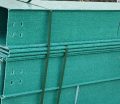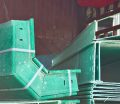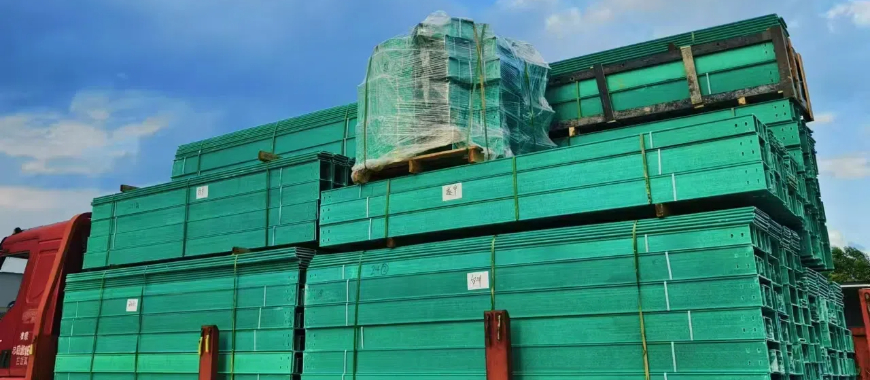
In industrial and corrosive environments, protecting electrical wiring and cables from damage is crucial for maintaining safety and efficiency. Chemical resistant cable trays are essential in such settings as they provide the necessary support while resisting the harmful effects of chemicals, moisture, and other corrosive substances. Electro Zinc Plated chemical resistant cable tray protects FRP fiberglass tray from corrosion, heat-dispersion and supports Tray Cable. Choosing the right cable tray for harsh chemical exposure involves considering key factors such as material composition, durability, and the level of chemical resistance needed. It’s important to select a cable tray that is compatible with the specific types of chemicals present in the environment, ensuring long-term protection and reliability. Chemical resistant cable trays are vital for ensuring operational continuity, preventing accidents, and minimizing maintenance costs in challenging industrial conditions.
What is a Chemical Resistant Cable Tray?
A chemical resistant cable tray is a specialized type of cable management system designed to support and organize electrical cables while protecting them from exposure to corrosive chemicals, moisture, and harsh environmental conditions. These trays are constructed from materials that are highly durable and capable of withstanding chemical exposure, ensuring the integrity of the cables and the safety of the surrounding environment.
Definition
The primary function of a cable tray for corrosive environments is to provide a secure, long-lasting solution for cable management in areas where regular trays would degrade due to chemical reactions. These trays are made from materials such as fiberglass, stainless steel, or polymer composites, which offer superior resistance to corrosion, preventing potential damage to the cables they carry.
Applications
Chemical resistant cable trays are widely used in industries like chemical processing, oil and gas, wastewater treatment, and pharmaceutical manufacturing. In chemical plants, they help protect sensitive cables from chemicals that could cause deterioration, while in oil and gas facilities, they shield cables from both corrosive substances and extreme environmental conditions. These trays ensure the continuous operation of essential electrical systems in industries where safety and reliability are paramount.
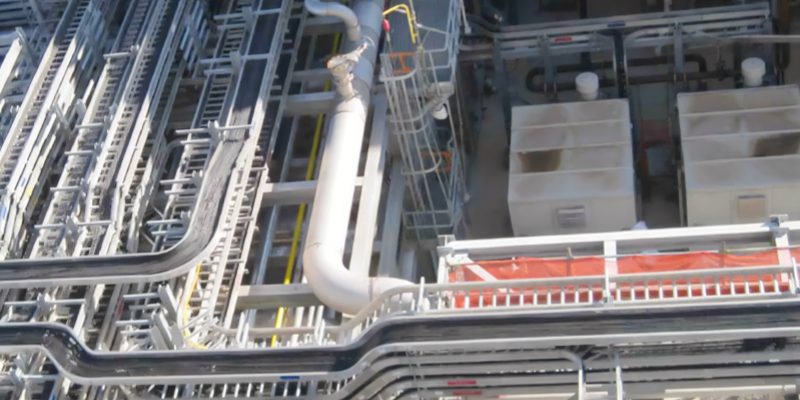
How Cable Tray Skirting Can Enhance Your Workspace Design
Types of Chemical Resistant Cable Trays
Chemical resistant cable trays come in various types, each designed to meet the unique demands of different industrial environments. The right type of tray depends on factors such as the level of chemical exposure, the size of the cable management system, and specific environmental conditions. Below are some common types of chemical resistant cable trays used across industries:
Closed Cable Tray
A closed cable tray is a fully enclosed system that shields cables from chemicals, moisture, and contaminants. Its sealed design prevents corrosion, damage, and electrical faults, ensuring long-term safety and reliability. An adjustable cable tray option offers flexibility for varying cable volumes or spaces while maintaining full enclosure. Ideal for harsh environments like chemical plants and pharmaceutical factories, it delivers maximum protection where cables face extreme conditions.
Channel Cable Tray
A channel cable tray features a compact, durable one-piece design with an open bottom and sides, allowing quick access to cables for installation or maintenance. While simpler than fully enclosed options, it still provides reliable protection against moderate chemical exposure. Its versatility and ease of adjustment make it ideal for tight spaces, such as laboratories, small-scale chemical plants, or manufacturing units handling light-duty cable management needs.
Aluminum Cable Tray
An aluminum cable tray is a lightweight yet durable solution for managing cables in industrial environments with mild to moderate corrosive conditions. Resistant to moisture, salt, and various chemicals, it ensures long-lasting performance while being easy to handle and install. Its excellent strength-to-weight ratio reduces labor and costs, and with a range of standard sizes available, it can be customized to fit both small setups and large-scale cable management systems.
Fiberglass Reinforced Plastic (FRP) Cable Tray
An FRP cable tray is a non-metallic, chemical-resistant solution ideal for extreme environments. Lightweight, non-conductive, and highly durable, an FRP cable tray withstands harsh chemicals, high temperatures, UV exposure, and moisture without corroding or rusting. Its minimal maintenance needs and long service life make it perfect for facilities requiring reliable cable protection, such as chemical plants, marine settings, or outdoor installations exposed to aggressive environmental conditions.
Issues with Problem Cable Tray in Concrete Slabs Explained
Advantages of Using Chemical Resistant Cable Trays
Chemical resistant cable trays offer numerous benefits, particularly in industries where electrical systems are exposed to corrosive substances and harsh environments. These trays not only provide a safe and effective way to manage cables but also help reduce operational risks and long-term maintenance costs. Below are the key advantages of using chemical resistant cable trays:
Durability
Chemical resistant cable trays are built to endure harsh chemicals, moisture, and extreme conditions without losing structural integrity. Made from materials like fiberglass, stainless steel, or aluminum, they resist corrosion, rust, and chemical attacks. Their long service life reduces the need for frequent replacements, making them ideal for industries such as chemical processing, oil and gas, and wastewater treatment.
Cost-Effectiveness
Although chemical resistant cable trays may cost more upfront, they deliver significant savings over time. Their durability minimizes replacement needs and lowers maintenance expenses. By preventing chemical damage and reducing downtime from repairs, they provide a cost-effective solution for industries requiring long-term, reliable cable management in challenging and corrosive environments.
Safety
Chemical resistant cable trays enhance safety by shielding cables from harmful chemicals, moisture, and other environmental hazards. This protection prevents corrosion and reduces the risk of electrical fires or system failures. By minimizing the chance of accidents, they help maintain safer working conditions in hazardous industries where electrical reliability is critical.
Versatility
These trays are adaptable to various installations, from small-scale operations to large industrial systems. Effective in industries like oil and gas, pharmaceuticals, and wastewater treatment, they withstand extreme temperatures, humidity, and UV exposure. Their resilience in diverse environmental conditions makes them a versatile solution for many industrial cable management needs.
Additional Benefits
Lightweight and modular designs make chemical resistant cable trays easy to install, reducing labor time and costs. Their resistance to a wide range of chemicals ensures cables remain protected and functional for years, with minimal maintenance. This combination of convenience, durability, and reliability makes them an essential choice for harsh operating environments.
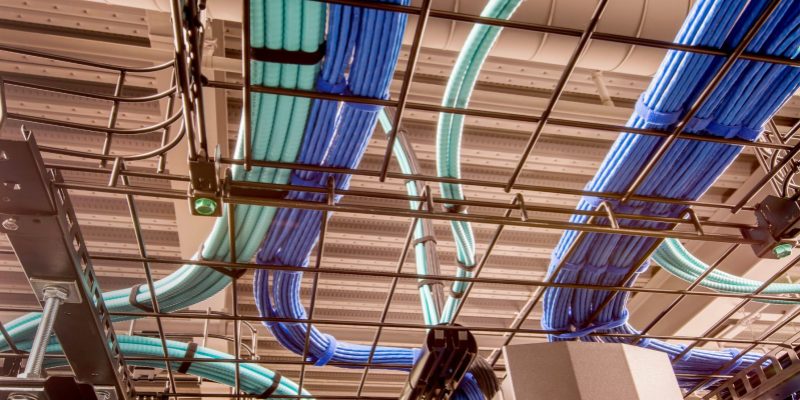
How to Secure Cable Tray on Flatbed for Safe Transport
Factors to Consider When Selecting a Chemical Resistant Cable Tray
Selecting the right chemical resistant cable tray is crucial for ensuring the protection and longevity of electrical systems, particularly in environments with corrosive chemicals, extreme temperatures, and other challenging conditions. The choice of tray depends on several key factors that affect its performance, durability, and suitability for the specific application. Below are the critical factors to consider when selecting a chemical resistant cable tray.
Material Composition
The material of the chemical resistant cable tray plays a significant role in determining its overall performance and longevity. Different materials offer varying levels of resistance to chemicals, moisture, and environmental stress, so selecting the right material is essential for ensuring the tray meets the demands of the environment.
- Aluminum: Lightweight and corrosion-resistant, aluminum chemical resistant cable trays are ideal for moderate exposure to chemicals and environmental factors. They are often used in industries such as food processing and general manufacturing.
- Fiberglass: Known for its superior chemical resistance, fiberglass is a non-metallic material that provides excellent protection against aggressive chemicals, extreme temperatures, and high humidity. Fiberglass chemical resistant cable trays are suitable for harsh environments, such as chemical processing plants and oil refineries.
- Coated Steel: For environments that require the mechanical strength of steel, coated steel trays offer a good balance of strength and corrosion resistance. The coating protects the steel from chemical exposure while maintaining its load-bearing capacity, making it ideal for industries like construction or heavy manufacturing.
Tray Type
Chemical resistant cable trays come in various designs, each suited to different installation and environmental needs. The type of tray you select will depend on the nature of the installation and the specific environment in which the tray will be used.
- Closed Cable Tray: Fully enclosed, providing maximum protection from chemicals, dirt, and moisture. This tray is ideal for high-risk environments where cable protection is paramount, such as in chemical plants or hazardous waste facilities.
- Channel Cable Tray: A compact and simple design that is suitable for smaller-scale applications or environments where space is limited. These trays offer sufficient protection for lighter-duty applications but are less secure than fully enclosed systems.
- Perforated Cable Tray: Perforated Cable Tray, often paired with Perforated Ladder designs, features perforated sides and bottoms to provide ventilation and flexibility, making them a good option for environments with fluctuating temperatures or where cable cooling is important. They are commonly used in commercial or industrial settings where moderate chemical exposure is expected.
Load Capacity
It is essential to ensure that the chemical resistant cable tray has the appropriate load capacity to support the weight of the cables it will carry. Incorrectly sized trays can result in sagging, misalignment, or even failure, leading to potential safety hazards or downtime.
- Weight Considerations: Always consider the total weight of the cables, including any additional components such as connectors or protective sheathing. The tray should be able to support this weight without compromising structural integrity.
- Industry-Specific Requirements: Different industries may have specific load requirements, particularly in settings where cables are heavier or more numerous, such as in power plants or large manufacturing facilities.
Size
The size of the chemical resistant cable tray must be compatible with the volume of cables and the available routing space. Oversized trays can lead to inefficient use of space, while undersized trays may not provide adequate protection or could lead to overcrowding, which can damage cables.
- Cable Volume: Estimate the total number of cables that will be routed through the tray. This includes any future expansion plans to ensure that the tray can handle the cables’ total volume over time.
- Routing Space: Consider the available physical space where the tray will be installed. Chemical-resistant cable trays come in various sizes, and the cable tray height is a critical factor in ensuring that the tray fits within the space while allowing for proper cable management and ventilation.
Additional Factors
- Environmental Conditions: Consider factors such as temperature extremes, exposure to UV rays, and the presence of flammable or explosive materials in the environment. These factors can influence the selection of materials and tray designs.
- Code Compliance: Ensure that the selected chemical-resistant cable tray meets relevant safety and industry standards. Adhering to the cable tray electrical code is essential to guarantee the tray’s compliance with regulations like those specified by the National Electrical Code (NEC) or other local guidelines.
By considering these factors when selecting a chemical resistant cable tray, you can ensure that the system is safe, effective, and durable, providing long-term protection for your cables in even the most challenging environments.
Common Applications of Chemical Resistant Cable Trays
Chemical resistant cable trays are essential in various industries where cables need protection from harsh chemicals, extreme environments, and moisture. These trays help maintain the integrity of electrical systems, ensuring safety, efficiency, and compliance with industry regulations. Below are some of the most common applications where chemical resistant cable trays are used.
Chemical Processing Plants
In chemical processing plants, chemical resistant cable trays protect cables from acids, solvents, and other aggressive chemicals present in production. Made from materials like fiberglass or coated steel, they resist corrosion, prevent electrical failures, and ensure safe cable routing in harsh environments with frequent chemical spills, splashes, or vapors, keeping operations running smoothly.
Wastewater Treatment Facilities
Chemical resistant cable trays in wastewater treatment plants withstand constant exposure to moisture, humidity, and harsh chemicals such as chlorine or bleach. Made from fiberglass or stainless steel, they resist rust and corrosion, ensuring long-term reliability. The cable tray function here is to support and protect cables from both environmental and chemical damage, maintaining continuous operation in challenging treatment conditions.
Oil and Gas Industries
In oil and gas operations, chemical resistant cable trays endure hydrocarbons, saltwater, and extreme temperatures. They protect cables from oils, fuels, and petrochemicals in refineries, resist saltwater corrosion on offshore platforms, and withstand temperature fluctuations. Careful cable tray measurement ensures proper fit and optimal performance, with their durability guaranteeing reliable cable systems in some of the harshest and most corrosive industrial environments worldwide.
Pharmaceutical Manufacturing
In pharmaceutical manufacturing, chemical resistant cable trays maintain clean, contaminant-free cable routing to meet strict hygiene and regulatory standards. They resist corrosive substances, prevent cross-contamination, and ensure cables remain free from dust and dirt. These trays are crucial in maintaining Good Manufacturing Practice (GMP) compliance within sensitive production areas.
Additional Applications
Chemical resistant cable trays are also vital in the food and beverage industry, resisting cleaning chemicals and moisture in processing areas. In marine and coastal environments, they protect electrical systems from saltwater corrosion and harsh weather, ensuring reliable performance for ships, ports, and offshore installations where environmental exposure is severe.
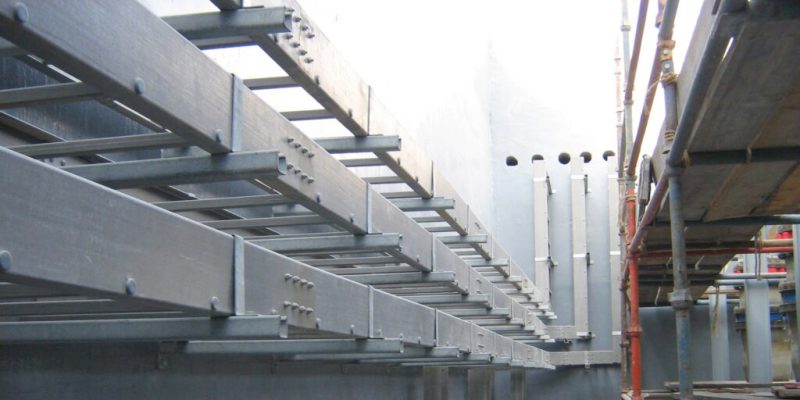
FAQs about Chemical Resistant Cable Tray
When choosing the best material for cable trays in corrosive environments, it is essential to consider the type of chemicals or environmental factors the tray will be exposed to. Fiberglass reinforced plastic (FRP) is often the best option for highly corrosive environments, as it is resistant to a wide range of chemicals, moisture, and extreme temperatures. FRP trays are non-metallic, lightweight, and non-conductive, making them ideal for chemical plants, oil refineries, and wastewater treatment facilities.
Another excellent option is stainless steel, particularly for environments with moderate corrosion risks, such as those with exposure to saltwater, oils, or mild acids. Stainless steel trays are strong, durable, and resistant to corrosion but may not withstand highly acidic or aggressive chemicals as well as FRP.
For environments with less severe exposure to corrosive elements, aluminum cable trays can be a good choice, as they provide a combination of corrosion resistance and lightweight properties, making them cost-effective and easy to install.
In a caustic environment, where exposure to highly corrosive substances like alkalis, acids, or other aggressive chemicals is prevalent, cable trays should be coated with protective materials to prevent corrosion. The most common coatings for cable trays in these environments include epoxy coatings and polyester powder coatings.
Epoxy Coating: Epoxy coatings are highly effective in protecting metal cable trays from chemical damage, moisture, and corrosion. This coating creates a durable, protective barrier that prevents chemicals from coming into direct contact with the tray surface, ensuring a longer lifespan for the tray. Epoxy is commonly used in environments exposed to both alkaline and acidic substances.
Polyester Powder Coating: This is another popular option for caustic environments due to its excellent resistance to corrosion and UV degradation. Polyester powder coatings are applied electrostatically and then cured under heat, forming a hard and protective layer over the cable tray. This coating is ideal for environments with exposure to harsh weather conditions or chemical spills.
For highly specialized applications, galvanized coatings (either hot-dip or electro-galvanized) can also be used for extra protection, particularly in environments with less intense chemical exposure.
There are three primary types of cable trays used for cable management in industrial applications:
Ladder Cable Tray: This is the most common and versatile type of cable tray. It consists of two side rails connected by rungs, forming a ladder-like structure. Ladder cable trays provide excellent ventilation for cables, preventing overheating and allowing easy installation and maintenance. This type is ideal for environments with high cable volumes and in areas requiring airflow around the cables.
Solid Bottom Cable Tray: As the name suggests, solid bottom trays have a continuous base, offering full protection to the cables from dust, debris, and other contaminants. They are commonly used in environments where additional protection is needed, such as cleanrooms or areas with high chemical exposure. Solid bottom trays are ideal for applications that require cable shielding from both physical and environmental hazards.
Perforated Cable Tray: This type of tray has a perforated or punched surface, allowing for better ventilation and easier access for installation and maintenance. It’s a flexible option that can be used in most environments, though it’s particularly suitable for lighter-duty applications and spaces where there’s moderate chemical exposure. The perforated design also helps reduce the overall weight of the tray while maintaining strength.
Not all types of cables are suitable for installation on cable trays. Specifically, cables that do not meet certain design and safety requirements should not be installed in cable trays. The following types of cables are typically not allowed:
Flexible Cables: Flexible cables, such as extension cords or other highly flexible power cords, should not be installed in cable trays because they are not designed for fixed, open-air installations. These cables can become damaged due to bending or environmental factors.
Cables with Low-Temperature Ratings: Cables not rated for the temperature range of the environment in which they are being installed should not be placed in cable trays. For example, cables with low-temperature insulation may crack or become brittle in colder environments.
Cables Without Proper Insulation: Cables lacking appropriate insulation or sheath materials for the given environment should not be used in cable trays, particularly in environments where moisture or chemicals are present. Cables without adequate insulation may lead to electrical shorts or fires.
Non-Armored Cables: In environments where there is a risk of physical damage, non-armored cables are not suitable for use in cable trays. Armored cables provide added protection against mechanical stress, vibration, and impacts, making them more appropriate for such installations.
Always ensure the cables installed in trays are rated for the specific conditions of the environment and meet local electrical codes and safety standards to prevent damage or safety hazards.

As the editor of GangLong Fiberglass, I have years of experience and in-depth research, focusing on cable tray products, fiberglass solutions, and grille systems. I incorporate years of industry insights and practical experience into every content, committed to promoting the progress of the industry. At GangLong Fiberglass, my commitment is reflected in every product, from innovative cable trays to durable fiberglass solutions and sturdy grille systems. As an authoritative voice in the industry, my goal is to provide valuable information to professionals and businesses and promote forward-looking solutions.

